
3
•
To reduce the risk of injury in ap-
plications that produce a consid-
erable amount of dust, use an OSHA compliant
dust extraction solution in accordance with the
solution’s operating instructions.
• Always use common sense and be cautious when
using tools. It is not possible to anticipate every
situation that could result in a dangerous outcome.
Do not use this tool if you do not understand these
operating instructions or you feel the work is beyond
your capability; contact Milwaukee Tool or a trained
professional for additional information or training.
• Maintain labels and nameplates. These carry im-
portant information. If unreadable or missing, contact
a MILWAUKEE service facility for a free replacement.
•
Some dust created by power sanding,
sawing, grinding, drilling, and other
construction activities contains chemicals known to
cause cancer, birth defects or other reproductive harm.
Some examples of these chemicals are:
• lead from lead-based paint
• crystalline silica from bricks and cement and other
masonry products, and
• arsenic and chromium from chemically-treated lumber.
Your risk from these exposures varies, depending on
how often you do this type of work. To reduce your
exposure to these chemicals: work in a well ventilated
area, and work with approved safety equipment, such
as those dust masks that are specially designed to
lter out microscopic particles.
EXTENSION CORDS
Grounded tools require a three wire extension cord.
Double insulated tools can use either a two or three wire
extension cord. As the distance from the supply outlet
increases, you must use a heavier gauge extension
cord. Using extension cords with inadequately sized
wire causes a serious drop in voltage, resulting in loss
of power and possible tool damage. Refer to the table
shown to determine the required minimum wire size.
The smaller the gauge number of the wire, the greater
the capacity of the cord. For example, a 14 gauge cord
can carry a higher current than a 16 gauge cord. When
using more than one extension cord to make up the total
length, be sure each cord contains at least the minimum
wire size required. If you are using one extension cord for
more than one tool, add the nameplate amperes and use
the sum to determine the required minimum wire size.
Guidelines for Using Extension Cords
• If you are using an extension cord outdoors, be sure
it is marked with the sufx “W-A” (“W” in Canada) to
indicate that it is acceptable for outdoor use.
• Be sure your extension cord is properly wired and in good
electrical condition. Always replace a damaged extension
cord or have it repaired by a qualied person before using it.
• Protect your extension cords from sharp objects,
excessive heat and damp or wet areas.
Recommended Minimum Wire Gauge
For Extension Cords*
Nameplate Amps
Extension Cord Length
25' 50' 75' 100' 150'
0 - 2.0
2.1 - 3.4
3.5 - 5.0
5.1 - 7.0
7.1 - 12.0
12.1 - 16.0
16.1 - 20.0
18
18
18
18
16
14
12
18
18
18
16
14
12
10
18
18
16
14
12
10
--
18
16
14
12
10
--
--
16
14
12
12
--
--
--
* Based on limiting the line voltage drop to ve volts at 150%
of the rated amperes.
READ AND SAVE FOR ALL
INSTRUCTIONS FOR FUTURE USE
GROUNDING
Improperly connecting the ground-
ing wire can result in the risk of
electric shock. Check with a qualied electrician if
you are in doubt as to whether the outlet is prop-
erly grounded. Do not modify the plug provided
with the tool. Never remove the grounding prong
from the plug. Do not use the tool if the cord or
plug is damaged. If damaged, have it repaired by a
MILWAUKEE service facility before use. If the plug
will not t the outlet, have a proper outlet installed
by a qualied electrician.
Grounded Tools:
Tools with Three Prong Plugs
Tools marked “Grounding Required” have a three wire
cord and three prong grounding plug. The plug must be
connected to a properly grounded outlet (See Figure A).
If the tool should electrically malfunction or break
down, grounding provides a low resistance path to
carry electricity away from the user, reducing the risk
of electric shock.
The grounding prong in the plug is connected through
the green wire inside the cord to the grounding system
in the tool. The green wire in the cord must be the only
wire connected to the tool's grounding system and
must never be attached to an electrically “live” terminal.
Your tool must be plugged into an
Fig. A
appropriate outlet, properly installed
and grounded in accordance with all
codes and ordinances. The plug and
outlet should look like those in Figure A.
Double Insulated Tools:
Tools with Two Prong Plugs
Tools marked “Double Insulated” do not require ground-
ing. They have a special double insulation system which
satises OSHA requirements and complies with the
applicable standards of Underwriters Laboratories, Inc.,
the Canadian Standard Association and
Fig. B
Fig. C
the National Electrical Code. Double
Insulated tools may be used in either of
the 120 volt outlets shown in Figures B
and C.
SPECIFICATIONS
Cat. No. ....................................................... 6520-21
Volts ...............................................................120 AC
Amps .................................................................... 13
Length of Stroke ..............................................1-1/8"
Strokes per Minute ...................................... 0 - 2800
Cat. No. ....................................................... 6523-21
Volts ...............................................................120 AC
Amps .................................................................... 13
Length of Stroke ..............................................1-1/4"
Strokes per Minute ...................................... 0 - 3000
Cat. No. ....................................................... 6536-21
Volts ...............................................................120 AC
Amps .................................................................... 13
Length of Stroke ..............................................1-1/4"
Strokes per Minute ...................................... 0 - 3000
Cat. No. ....................................................... 6538-21
Volts ...............................................................120 AC
Amps .................................................................... 15
Length of Stroke ..............................................1-1/4"
Strokes per Minute ...................................... 0 - 2800

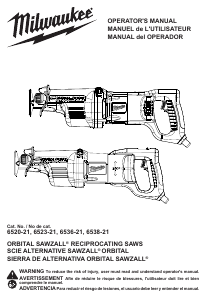


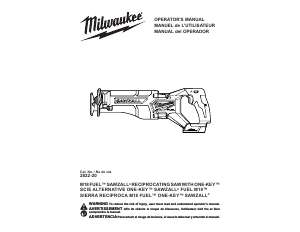
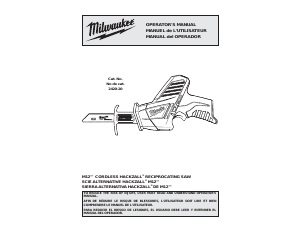
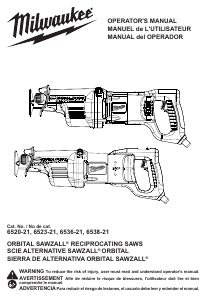
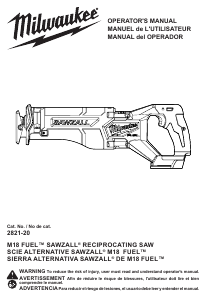
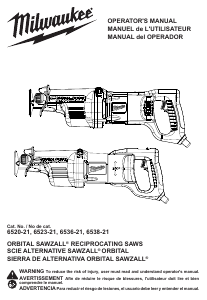
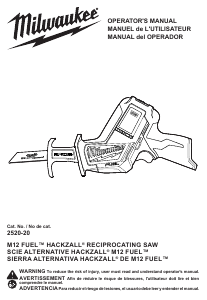
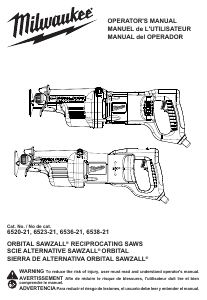
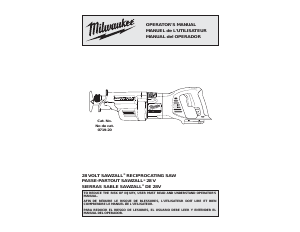
Join the conversation about this product
Here you can share what you think about the Milwaukee 6520-21 Reciprocating Saw. If you have a question, first carefully read the manual. Requesting a manual can be done by using our contact form.